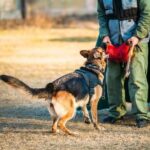Separation anxiety can be a challenging issue for both dogs and their owners. Imagine coming home to find your beloved furry friend in a state of distress every time you leave them alone. This is a common problem known as separation anxiety, and it affects countless dogs across the globe.
In this article, we will delve into the world of separation anxiety in dogs, exploring what it is and how it impacts our four-legged companions. We will also discuss the signs and symptoms to look out for, providing valuable insight into this often misunderstood condition.
Separation anxiety is a condition that arises when dogs become anxious or panicked when separated from their owners or left alone. It can manifest in various ways, ranging from excessive barking and destructive behaviors to drooling or trembling uncontrollably. Understanding these signs is crucial for pet owners as they can help determine whether their dog is suffering from separation anxiety or simply experiencing normal emotions of boredom or loneliness.
Proper training plays a vital role in addressing separation anxiety in dogs. Without effective techniques, this condition can worsen over time and impact not only your dog’s well-being but also your own peace of mind. In this article, we will emphasize the importance of training methods specifically designed for dogs with separation anxiety and discuss the potential consequences of leaving this condition untreated.
By gaining a deeper understanding of separation anxiety in dogs and acknowledging its impact on their behavior, you will be better equipped to provide the necessary support for your furry friend. Together, let’s explore the intricacies of separation anxiety in order to empower ourselves with knowledge and practical strategies for helping our beloved companions overcome this challenging condition.
The Importance of Proper Training for Dogs with Separation Anxiety
Separation anxiety can be a challenging condition for dogs and their owners to navigate. It is crucial to understand the importance of proper training when dealing with separation anxiety in dogs. Without effective training techniques, this condition can worsen over time and lead to significant consequences for both the dog and the owner.
One of the primary reasons why proper training is essential for dogs with separation anxiety is that it helps address the root cause of the problem. Training can teach your dog coping mechanisms and help them feel more secure when left alone. By providing structure and clear boundaries, you are setting your dog up for success in managing their anxiety.
Furthermore, leaving separation anxiety untreated can have severe consequences for your dog’s overall well-being. Dogs with this condition may engage in destructive behaviors, such as excessive chewing or scratching, which can be harmful to their health and safety. They may also experience physical symptoms such as excessive drooling or panting, resulting in distress and discomfort. Proper training not only helps alleviate these symptoms but also promotes a healthier relationship between you and your furry friend.
In addition to addressing the immediate concerns of separation anxiety, proper training sets the foundation for long-term success in managing this condition. By teaching your dog techniques such as gradual desensitization and positive reinforcement, you are equipping them with lifelong skills to cope with stressful situations. Investing time and effort into training will not only help your dog overcome separation anxiety but also strengthen your bond with them, creating a happier and more harmonious home environment.
Building a Healthy Routine to Reduce Separation Anxiety
Establishing a proper routine is crucial when it comes to helping your dog cope with separation anxiety. Dogs are creatures of habit, and having a structured schedule can greatly reduce their stress and anxiety levels. In this section, we will discuss some tips on creating a healthy routine that minimizes stress and anxiety for your dog.
Tips for Establishing Consistency
When building a routine for your dog, consistency is key. It’s important to establish regular feeding, walking, and playtime schedules. Dogs feel most secure when they have clear expectations of daily activities. Make sure to feed your dog at the same times each day, take them for walks or exercise at consistent intervals, and set aside dedicated playtime.
Additionally, try to keep departures and arrivals as low-key as possible. Your dog may become anxious if they associate these moments with long periods of isolation. Avoid making a fuss or an elaborate farewell when leaving the house or coming back home. Instead, keep these interactions calm and simple.
Include Mental Stimulation
Incorporating mental stimulation into your dog’s routine can be highly beneficial in reducing separation anxiety. Engaging their minds through puzzle toys, treat-dispensing toys, or training sessions provides an outlet for their energy and helps distract them from any anxious thoughts.
Consider leaving interactive toys or safe chew treats for your dog while you’re away. These items can provide mental stimulation and help redirect any anxiety towards more positive behavior.
Gradual Changes
If you anticipate changes in your routine that could potentially trigger separation anxiety in your dog (such as going back to work after being at home during the pandemic), it’s essential to gradually introduce these changes rather than abruptly imposing them. Start by simulating short absences by leaving the house for a few minutes at a time and gradually increase the duration over a few weeks. This will help your dog adjust and build confidence in being alone.
Remember, each dog is unique, and it may take time to find the routine that works best for your furry friend. Be patient, observe their behavior, and make adjustments as necessary. With a consistent and healthy routine, you can significantly reduce separation anxiety in your dog and create an environment where they feel safe and secure.
Gradual Desensitization
Separation anxiety can be a challenging issue for both dogs and their owners. However, with the right training techniques, it is possible to help your dog become comfortable with being alone. One effective method is gradual desensitization, which involves slowly exposing your dog to being alone in a safe and positive environment.
The process of gradual desensitization requires patience and consistency. It involves gradually increasing the amount of time your dog spends alone, starting with just a few minutes and gradually working up to longer periods. This gradual approach helps your dog build confidence and reduces anxiety about being alone.
To begin the desensitization process, create a designated “alone space” for your dog that is secure and comfortable. This can be a specific room or area with their bed, toys, and water bowl. Start by leaving your dog alone in this space for just a few minutes while you are still within hearing range. Gradually increase the duration of time as your dog becomes more comfortable.
It’s important to make sure that your departure and arrival are low-key to avoid triggering anxiety in your dog. When leaving, avoid any emotional farewells or prolonged goodbyes. Similarly, when returning home, wait until your dog has calmed down before giving attention or engaging in playtime.
| Steps | Description |
|---|---|
| 1 | Create an “alone space” for your dog |
| 2 | Start with short periods of alone time |
| 3 | Increase the duration gradually |
| 4 | Avoid emotional farewells and arrivals |
In addition to gradually increasing alone time, you can also use positive reinforcement techniques to reward your dog for remaining calm during the desensitization process. This can include treats, praise, or a favorite toy. By associating being alone with positive experiences, your dog will start to view it as a normal and non-threatening situation.
It’s important to note that the desensitization process may take time, depending on the severity of your dog’s separation anxiety. Each dog is different and may progress at their own pace. If you encounter any challenges or if your dog’s anxiety worsens during the training, it may be beneficial to consult with a professional dog behaviorist or trainer.
By following the gradual desensitization process and using positive reinforcement techniques, you can help your dog overcome separation anxiety and develop confidence in being alone. Remember to be patient, consistent, and supportive throughout the entire training journey. With time and effort, you’ll be able to teach your dog that being alone is not something to fear but rather an opportunity for relaxation and independence.
Positive Reinforcement Techniques for Treating Separation Anxiety
When it comes to addressing separation anxiety in dogs, positive reinforcement techniques can be highly effective. Positive reinforcement training involves rewarding and encouraging desired behaviors, which can help your dog overcome their anxiety and develop a more calm and relaxed state of mind. By using this approach, you can create a positive association with being alone, ultimately helping your dog feel more comfortable when you’re not around.
One way to implement positive reinforcement is by offering rewards or treats when your dog exhibits calm behavior during periods of separation. For example, you can give your dog a special toy or treat every time they stay relaxed while you’re out of the house. This not only helps distract them from their anxious thoughts but also associates being alone with something enjoyable.
In addition to treats, verbal praise and affection are important components of positive reinforcement training. When your dog remains calm during times when they would typically experience separation anxiety, shower them with praise and attention. Offer gentle petting or verbal cues like “good boy” or “good girl” to reinforce their calm behavior. This will help them understand that being alone is not something to fear, but rather an opportunity for rewards and positive attention.
Using a combination of rewards, treats, and verbal praise will strengthen the bond between you and your dog while also teaching them that being alone is not a negative experience. It’s important to note that consistency is key when implementing positive reinforcement techniques. Be patient with your dog as they learn to cope with separation anxiety, and remember to consistently reward their progress.
By using these positive reinforcement techniques consistently over time, you can effectively train your dog to deal with separation anxiety in a way that promotes confidence and relaxation. These methods can help transform your dog’s anxious behaviors into positive ones, allowing them to lead happier lives even when you’re apart.
Key Points:
- Positive reinforcement training involves rewarding desired behaviors during periods of separation.
- Rewards can include treats, toys, verbal praise, and affection.
- Consistency is key when implementing positive reinforcement techniques.
Calming Techniques
Separation anxiety can be a challenging condition for dogs to overcome, as it often leads to intense emotional distress when left alone. As a dog owner, it is crucial to provide your furry friend with the tools and techniques they need to manage their anxiety. One effective way to help soothe your dog’s anxiety is through the use of calming techniques.
- Playing Soft Music: Just like humans, dogs can find comfort in soothing sounds. Playing soft music or creating a calming playlist specifically designed for dogs can help reduce their anxiety levels. The rhythmic nature of classical music or tracks composed specifically for dogs can have a relaxing effect on their nervous system.
- Natural Remedies: In some cases, natural remedies can be used to alleviate separation anxiety in dogs. Certain herbal supplements, such as chamomile or lavender, have calming properties that can help relax your furry friend. However, it is important to consult with your veterinarian before using any natural remedies to ensure they are safe for your dog and that the proper dosage is administered.
- Utilizing Anxiety Wraps: Anxiety wraps or vests are special garments designed to apply gentle pressure to specific areas of your dog’s body, which can have a calming effect on them. These wraps work similarly to swaddling a baby and create a sense of security for dogs experiencing anxiety. They are especially useful during thunderstorms, fireworks, or when leaving your dog alone.
By incorporating these calming techniques into your dog’s routine, you can help them feel more relaxed and comfortable when facing separation anxiety. Remember that every dog is unique, so it may take some trial and error to find the most effective technique for soothing their anxiety.
Table
| Calming Techniques | Description |
|---|---|
| Playing Soft Music | Playing soothing music can help reduce anxiety levels in dogs. |
| Natural Remedies | Certain herbal supplements like chamomile or lavender can have calming properties for dogs. |
| Anxiety Wraps | Anxiety wraps apply gentle pressure to specific areas of a dog’s body, providing a sense of security and comfort. |
Professional Help
While many cases of separation anxiety in dogs can be effectively addressed through training and behavior modification techniques, there are instances where professional help may be necessary. Recognizing the signs that indicate your dog’s separation anxiety may require the expertise of a dog behaviorist or trainer is crucial for providing the best care for your canine companion.
So, when should you consider seeking professional assistance? If your dog exhibits severe symptoms of separation anxiety such as destructive behavior, excessive barking or howling, self-harm, or even escape attempts, it may be time to consult a professional. These behaviors can not only be distressing for your dog but can also lead to potential harm or damage to themselves or your home.
A dog behaviorist or trainer specialized in separation anxiety can provide invaluable support by assessing the severity of your dog’s condition and tailoring a comprehensive treatment plan. They have the knowledge and experience to address complex cases of separation anxiety and can offer guidance on effective techniques specific to your dog’s needs. Additionally, they can teach you valuable skills and strategies that will empower you to better understand and communicate with your furry friend.
When seeking professional help, it’s essential to choose a certified and experienced dog behaviorist or trainer who specializes in separation anxiety. Look for someone who uses positive reinforcement methods rather than punitive approaches. With their expertise and guidance, you’ll feel more confident in helping your dog overcome separation anxiety and creating a happier life for both of you.
Maintaining Progress
Once you have successfully trained your dog to cope with separation anxiety, it is important to implement long-term strategies to prevent the recurrence of this issue. Consistency and reinforcement of positive behavior are key to ensuring that your dog continues to feel calm and secure when left alone. Here are some tips for maintaining progress and preventing separation anxiety in the long run.
Firstly, it is crucial to stick to the routine that you have established during the training process. Dogs thrive on predictability, so maintaining a consistent schedule for feeding, exercise, and playtime will greatly reduce their overall stress levels. Make sure that you continue to allocate enough time each day for physical exercise and mental stimulation as this will help your dog release any pent-up energy and anxiety.
In addition to sticking with a regular routine, ongoing training is essential. By continuing to practice leaving your dog alone for short periods of time on a regular basis, you will reinforce their confidence and independence. Gradually increasing the duration of their alone-time sessions can further solidify their ability to remain calm and content in your absence. Remember to reward them with praise or treats when they display relaxed behavior during these practice sessions.
Another helpful strategy is to provide your dog with engaging toys or activities while you are away. Puzzle toys or treat-dispensing toys can keep them occupied and mentally stimulated during your absence, serving as a positive distraction from any potential anxiety triggers. However, be cautious not to rely solely on toys as a solution for preventing separation anxiety; building a strong foundation of training and routine is still vital.
Lastly, consider seeking additional support from professionals if needed. Dog trainers or behaviorists can provide guidance on how best to maintain progress specific to your dog’s individual needs and circumstances. They may offer additional techniques or exercises tailored towards preventing separation anxiety in the long term.
By following these long-term strategies, you can ensure that you are helping your dog overcome separation anxiety while also preventing its recurrence. Consistency and continued training, along with a structured routine and engaging activities, will help your dog feel secure and confident even when you are not around. With patience and dedication, you can provide your canine companion with a happy and anxiety-free life.
Conclusion
In conclusion, helping your dog overcome separation anxiety is a journey that requires patience, consistency, and proper training techniques. By understanding what separation anxiety is and recognizing the signs and symptoms, you can take the necessary steps to address this issue in your dog’s life.
Proper training is essential in managing separation anxiety. Leaving this condition untreated can lead to negative consequences such as destructive behavior, excessive barking, or even self-harm. By implementing gradual desensitization and positive reinforcement techniques, you can teach your dog to become comfortable with being alone and reward their calm behavior. Building a healthy routine with consistent feeding, walking, and playtime schedules also plays a crucial role in minimizing stress and anxiety for your furry friend.
While training at home can be effective for some dogs, severe cases of separation anxiety may require professional assistance from a dog behaviorist or trainer. These professionals have experience dealing with complex cases and can provide specialized therapies to help your dog overcome their anxiety. It’s important to recognize the signs that indicate the need for professional help and not hesitate to reach out when necessary.
Remember that overcoming separation anxiety is an ongoing process that requires long-term strategies. Maintaining progress involves maintaining consistency in training methods, reinforcing positive behavior regularly, and continuing to build confidence in your dog’s ability to cope with being alone. With patience and proper training techniques, you can help your beloved pet lead a happy and anxiety-free life.
Frequently Asked Questions
Can separation anxiety be trained out of a dog?
Separation anxiety in dogs can be managed and improved through training, but it cannot necessarily be completely eliminated. Dogs with separation anxiety often experience distress when left alone, exhibiting behaviors like excessive barking, destructive chewing, or inappropriate elimination.
Training techniques such as gradual desensitization and counterconditioning can help reduce a dog’s anxiety levels and teach them to cope better with being alone. However, it is important to remember that some dogs may always have a heightened sensitivity to being separated from their owners due to their individual temperament or previous experiences.
How do you break separation anxiety in dogs?
Breaking separation anxiety in dogs requires a combination of patience, consistent training methods, and sometimes professional guidance. The first step is to create a positive association with being alone by gradually increasing the time spent apart from the dog. This can start with short intervals where the dog is in another room while their owner remains nearby, slowly progressing to longer periods of separation as they build confidence.
Providing toys or treats that are only given during these alone times can also help distract the dog and make the experience more enjoyable. Seek advice from a professional trainer or animal behaviorist if the issue persists or worsens.
What triggers separation anxiety in dogs?
Several triggers can contribute to separation anxiety in dogs. Common causes include sudden changes in routine or environment such as moving homes, experiencing the loss of a family member (human or animal), or changes in the household dynamics (such as new arrivals). Dogs who have experienced abandonment or neglect in the past may also be particularly prone to developing separation anxiety.
Additionally, certain breeds known for their attachment to their owners, such as Labrador Retrievers or German Shepherds, may be more susceptible to developing separation anxiety compared to others. Understanding these triggers can help identify potential causes and guide efforts towards managing and alleviating the anxiety experienced by dogs when separated from their owners.

Welcome to the blog! I am a professional dog trainer and have been working with dogs for many years. In this blog, I will be discussing various topics related to dog training, including tips, tricks, and advice. I hope you find this information helpful and informative. Thanks for reading!





